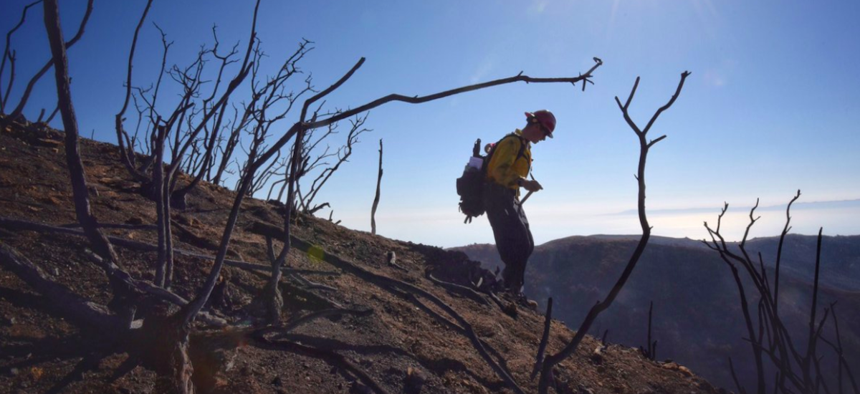With California’s Largest Wildfire on Record Nearly Contained, Officials Warn of New Danger

Santa Barbara County Fire Capt. Ryan Thomas hikes down steep terrain below East Camino Cielo while fighting the Thomas Fire on Dec. 19, 2017. Mike Eliason / Santa Barbara County Fire Department

Connecting state and local government leaders
The Thomas Fire has been winding down but the risk of mudslides has put state and local agencies on alert. “Every canyon within this burn zone is at risk.”
Nearly month after the Thomas Fire started in Ventura County, the largest wildfire on record in California is now almost fully contained. As of Tuesday, CalFire reported that 92 percent of the Thomas Fire has been contained. The blaze has been blamed for two deaths, destroyed more than 1,000 structures and damaged 280 more. Nearly 500 firefighting personnel remain on the scene to finish containment, according to CalFire.
But after a grueling and difficult month dealing with the quickly expanding blaze, which spread from Ventura County into neighboring Santa Barbara County, emergency management officials are warning of a new danger in the fire zone: mudslides.
With vegetation that typically holds soil together now burned, new winter rainfall coming this week—which drought-prone California desperately needs—is poised to destabilize slopes and create mudslides.
"The Thomas Fire burned all of our front country range here," Tom Fayram, Santa Barbara County's deputy director of public works, told CNN in a recent interview. "All these hills normally have a protective cover of chaparral. That's all gone. Almost 100 percent gone," he said.
In a video interview posted to Facebook late last month, Ventura County Geologist Jim O’Tousa said that “every canyon within the burn zone is at risk” from a mudslide or a debris flow.
The risk from a post-fire mudslide doesn’t pass after the first rain, O’Tousa said. The danger can continue over multiple rain events, meaning that residents in or near the fire zone will need to be alert for many weeks.
Public works crews in Santa Barbara and Ventura counties are trying to keep storm drains clear of debris to reduce the risk.
In January 2005, a massive landslide in Ventura County killed 10 people in the small coastal community of La Conchita.
Michael Grass is Executive Editor of Government Executive's Route Fifty and is based in Seattle.

NEXT STORY: The Quandary of Designing Streets and Sidewalks to Protect Against Rare Events





